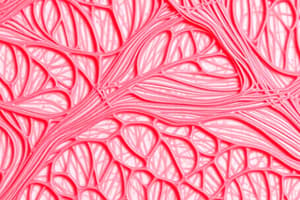Podcast
Questions and Answers
What is the organization of myofilaments in smooth muscle?
What is the organization of myofilaments in smooth muscle?
- Thin and thick filaments are present with no visible striations.
- The ratio of thin to thick filaments is the same as in skeletal muscle.
- Thick and thin filaments are arranged diagonally. (correct)
- Thick filaments have heads along their entire length.
What is the key difference between smooth muscle and skeletal muscle in terms of myofilament arrangement?
What is the key difference between smooth muscle and skeletal muscle in terms of myofilament arrangement?
- Skeletal muscle has no intermediate filament bundles unlike smooth muscle.
- Smooth muscle has a higher density of troponin complex than skeletal muscle.
- Skeletal muscle has a more diagonal arrangement of thick and thin filaments.
- Thick filaments in smooth muscle have heads along their entire length, unlike in skeletal muscle. (correct)
Which statement accurately describes the myofilaments in smooth muscle?
Which statement accurately describes the myofilaments in smooth muscle?
- Smooth muscle has sarcomeres similar to skeletal muscle.
- The ratio of thin to thick filaments is lower than in skeletal muscle. (correct)
- The arrangement of thick and thin filaments is the same as in cardiac muscle.
- There are no thick filaments present.
What is a characteristic feature of the arrangement of thick filaments in smooth muscle?
What is a characteristic feature of the arrangement of thick filaments in smooth muscle?
How do the thin and thick filaments in smooth muscle contribute to its contraction?
How do the thin and thick filaments in smooth muscle contribute to its contraction?
What distinguishes the myofilament organization in smooth muscle from skeletal muscle?
What distinguishes the myofilament organization in smooth muscle from skeletal muscle?
What is the main reason for the shortening of sarcomeres during muscle contraction?
What is the main reason for the shortening of sarcomeres during muscle contraction?
What is the role of T-tubules in muscle fibers?
What is the role of T-tubules in muscle fibers?
Which structure regulates intracellular calcium levels in muscle cells?
Which structure regulates intracellular calcium levels in muscle cells?
What is the function of smooth endoplasmic reticulum (SR) in muscle cells?
What is the function of smooth endoplasmic reticulum (SR) in muscle cells?
What component pairs form perpendicular cross channels within muscle cells?
What component pairs form perpendicular cross channels within muscle cells?
Which protein molecule hydrolyzes ATP during muscle contraction?
Which protein molecule hydrolyzes ATP during muscle contraction?
What gives muscle cells their striated appearance?
What gives muscle cells their striated appearance?
Which region contains tiny protein rods that hold adjacent thick filaments together in a sarcomere?
Which region contains tiny protein rods that hold adjacent thick filaments together in a sarcomere?
What is the chief protein component of thin filaments?
What is the chief protein component of thin filaments?
Which myofilament extends the entire length of dark A-bands?
Which myofilament extends the entire length of dark A-bands?
What are the two smaller, light polypeptide chains on each myosin molecule called?
What are the two smaller, light polypeptide chains on each myosin molecule called?
What are the two regulatory subunits bound to actin in thin filaments?
What are the two regulatory subunits bound to actin in thin filaments?
Flashcards are hidden until you start studying
Study Notes
Intercalated Discs
- Appear as dark, transverse lines that occur at irregular intervals in LM
- Exhibits two regions: transverse and lateral portions in EM
Skeletal Muscle
- Multinucleate with oval nuclei beneath the sarcolemma
- Nuclei are pushed aside by long, ribbon-like organelles called myofibrils
- Displays birefringence in polarized light
- Striated appearance due to alternating light (I) and dark (A) bands
Sarcomeres
- Structural and functional units of skeletal muscle
- Responsible for the striations of skeletal muscle
- Consist of light I-bands with a midline interruption called Z-disc and dark A-bands with a lighter central area called the H-zone
Myofilaments
- Thick (myosin) filaments extend the entire length of dark A-bands
- Thin (actin) filaments are present in the light I-bands
- Thick filaments composed of myosin molecules with rod-like tails and globular heads
- Thin filaments composed of actin, tropomyosin, and troponin
Sarcomere Arrangement
- Thick and thin filaments slide past each other, causing sarcomere shortening during muscle contraction
- Sliding filament theory explains muscle contraction
Muscle Contraction
- Motor units consist of a motor neuron and all the muscle fibers it activates
- Myosin ATPase hydrolyzes ATP, activating the myosin head and "cocking" it in an extended position
- Myosin head binds to an active site on actin, enabling muscle contraction
Smooth Muscle
- Non-striated, uninucleate, and fusiform in shape
- Thin and thick filaments are present, but with a higher ratio of thin to thick filaments compared to skeletal muscle
- Thick filaments have heads along their entire length, and there is no troponin complex
- Filaments are arranged diagonally, causing contraction in a corkscrew manner
- Non-contractile intermediate filament bundles attach to dense bodies at regular intervals
- Exhibits slow, synchronized contractions due to electrical coupling with gap junctions
- Some smooth muscle cells act as pacemakers, setting the contractile pace for the whole sheet of muscles
Studying That Suits You
Use AI to generate personalized quizzes and flashcards to suit your learning preferences.




